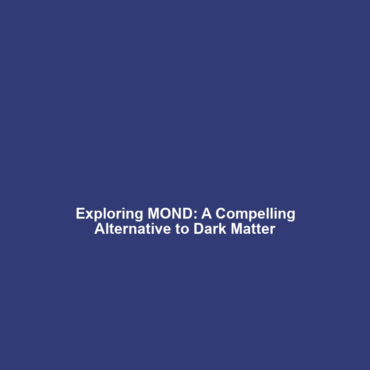Alternatives to Dark Matter: MOND (Modified Newtonian Dynamics)
Introduction
In the quest to understand the universe’s 95% mass-energy content, which comprises dark matter and dark energy, Modified Newtonian Dynamics (MOND) emerges as a compelling alternative to conventional dark matter theories. The significance of MOND lies in its potential to explain astronomical phenomena without invoking unseen matter, thereby challenging established cosmological models. This article delves into the principles of MOND, its implications for the field of astrophysics, and its relevance to the broader context of dark matter and dark energy.
Key Concepts
Modified Newtonian Dynamics (MOND) proposes an adjustment to Newton’s laws of motion to account for the observed rotation curves of galaxies. Traditional physics predicts that stars at the edges of galaxies should orbit slower than those near the center; however, observations show they move at similar speeds. MOND addresses this discrepancy by modifying the gravitational force at low accelerations.
Principles of MOND
- Violation of the weak equivalence principle in low-gravity environments.
- Redefinition of gravitational force to emerge at low accelerations.
- Success in explaining the dynamics of galaxies without requiring dark matter.
Applications and Real-World Uses
MOND’s principles have significant implications in astrophysics, particularly in explaining celestial mechanics and the behavior of galaxies and galaxy clusters. Some notable applications include:
- Analyzing rotation curves of spiral galaxies.
- Predicting the motion of satellite galaxies in relation to their host galaxies.
- Assessing gravitational lensing effects without dark matter models.
Understanding how MOND functions in the realm of dark matter and dark energy provides crucial insights into galaxy formation and evolution.
Current Challenges
Despite its strengths, MOND faces several challenges and limitations, including:
- Inability to explain cosmic microwave background radiation properties.
- Struggles to account for large-scale structure formation in the universe.
- Navigating inconsistencies with observations in the context of gravitational waves.
These challenges of MOND illustrate ongoing debates in dark matter and dark energy research.
Future Research and Innovations
Future research into MOND is focused on reconciling its principles with observations at larger cosmological scales. Innovations may include:
- The development of hybrid models integrating MOND with dark matter concepts.
- Advanced computational simulations to test MOND’s predictions against observational data.
- Adjustments that might allow MOND to seamlessly coexist with existing dark energy theories.
These initiatives represent the potential for breakthroughs in our understanding of dark matter and dark energy.
Conclusion
In conclusion, Modified Newtonian Dynamics (MOND) offers a fascinating alternative to dark matter, presenting unique insights into the mysterious forces shaping our universe. While it faces significant challenges, ongoing research promises to deepen our understanding of both MOND and broader cosmic phenomena. For further reading on related topics, check out our articles on Dark Matter and Dark Energy.
